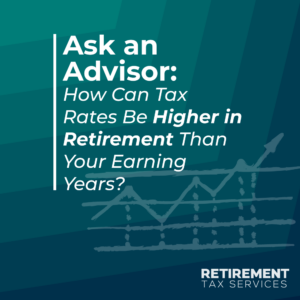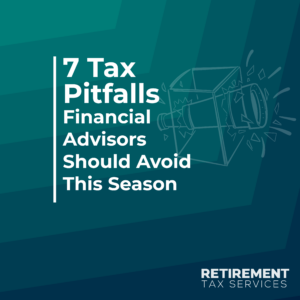Background
I was recently reviewing a tax return for an advisor. Something just didn’t seem quite right.
The advisor had not seen the return before sending it to me. However, he had given me an overview of what they had done in 2020 from a retirement-tax-planning standpoint.
In particular, I was told that the client had a large taxable IRA distribution: $40,000 of that was a Roth conversion. The rest was for the client’s use, including a withholding for taxes on the entire distribution.
So, I pulled open the 1040 (for 2020 IRA distributions are reported on lines 4a and 4b). I expected to see the full amount ($96,000) on line 4b, representing a taxable distribution. The advisor had helped process it. Even the 1099R showed that the entire distribution was taxable.
Therefore the advisor and I were both pretty surprised to see that only $32,000 showed on line 4b as a taxable distribution. This is where form 8915-E comes into play.
The New Qualifications: Form 8915-E
Form 8915 has been around for years. It covers what are called Qualified Disaster Retirement Plan Distributions. Every time the IRS revises the form, they add a new letter to the end, 8915-D covers 2019 and 8915-E covers 2020.
The 8915 series allows taxpayers impacted by qualified disasters to take distributions from their retirement accounts in the year of the disaster. Clients under 59½ are allowed to avoid the 10% penalty. They can also spread the distribution’s tax liability over 3 years.
Advisors in states that frequently have hurricanes and other natural disasters may be familiar with this. In the past, it has mostly covered natural disasters.
The IRS puts out a specific list of what’s considered a natural disaster each year. They also specify the time periods covered.
In 2020, due to the COVID-19 pandemic, the IRS updated its list. Form 8915-E was released to include the corona virus as a qualified disaster.
Resulting Opportunities
This was done in very broad terms. Nearly everyone could claim to be “impacted” by this particular qualified disaster. Whether they had the virus, cared for someone with it, or were simply negatively impacted financially, they could potentially be eligible.
The broadened definition of who qualifies created a huge opportunity for tax preparers. They can help clients who had taxable distributions during 2020 reduce their taxable income now, spreading it across 3 years instead of just one.
Since taxpayers do not have to specify a distribution as disaster-related when it is taken, this option can be taken through the year-end tax filing.
For many taxpayers, this could be a great opportunity. However, like most tax planning strategies, it needs customizing to specific client situations. You need to take a multiple-year view in making the decision.
Going back to the client I mentioned above, they expect significantly higher income in 2021 outside of the taxable portion of the 2020 distribution. So, the election was not as simple as spreading tax evenly over 3 years.
Play The Long Game
This means the $32,000 claimed as income in 2021 because of the disaster election will be taxed at a higher marginal rate than if the entire amount had been taxed in 2020.
This is a perfect example of why retirement tax planning strategies should be based on long-term tax projections. Looking at one year at a time is not how you stop overpaying the IRS.
This article is not a statement on whether using form 8915-E is good or bad. That is most certainly situational. A lot of details have to be considered in making that decision. Kitces.com author Jeffrey Lavine has a great article on this.
This situation is important because I keep hearing from advisors who have just discovered that a form 8915-E was filed for a client. In some situations, the advisor is left to help the client understand if it was the right decision.
The upper limit of $100,000 can be treated as a qualified disaster retirement plan distribution. Because of this, there is potential for $33,000 of taxable income in 2021 and 2022 with no associated cash flow to cover the tax payments.
Don’t Skip Form 8915-E’s Details
Use this as an opportunity to add value to your client: Take time to make sure they understand what this means for them now and in upcoming years.
Help them project what the tax bill is going to be in each of those years. Make sure they are planning ahead for those tax payments.
Also, make sure they know form 8915-E will have to be filed in 2021 and 2022. Explain that if they don’t, they can’t continue reporting and tracking where this taxable income comes from and it will raise red flags to the IRS.
This election does provide an option to repay the distribution within the three year time period. Carefully evaluate the impact on all three years (2020, 2021 and 2022) before making any recommendations to you clients.
Take Action
Here is what every great advisor should be doing:
- Make sure that you are getting the entire tax return for each of your clients. Do not settle for the 1040. Make sure you have all the supporting schedules and forms. The only way to know if a distribution was treated as a Qualified Disaster Retirement Distribution is on form 8915. Don’t expect that to show up on the face of the 1040.
- Review the form 8915-E. Learn the amount that was included on the form. Note whether the election was made to tax the distribution in one year (there is a box that has to be checked) or spread over 3 years (the default).
- Track this in your CRM: Record which clients filed a form 8915-E. Note the amount of taxable income that will be added to 2021 and 2022 as a result. This way any planning recommendations you make consider the whole picture.
Great advisors provide value in all aspects of their clients’ financial lives. Meanwhile, CPAs have no exclusive rights to all things tax-related. Many of them will thank you for taking these steps with your shared clients.
Even if you find yourself in a situation beyond your expertise, you can still serve your client and provide value: Partner with their tax expert. Don’t just sit back and say “Sorry, I don’t give tax advice.”
Check out our additional insights at Retirement Tax Services. Good luck out there and remember to tip your server, not the IRS.





